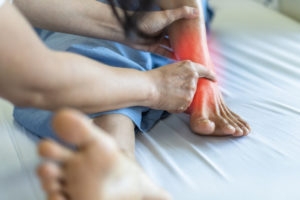Soft Tissue Injury

Your body’s musculoskeletal system has two types of tissue to give your body structure, strength, and flexibility. The bones consist of calcified parts that provide a rigid scaffold. The soft tissues consist of the non-calcified parts that hold your body together and make it move.
A soft tissue injury might sound minor. But some soft tissue injuries can have lifelong effects on your ability to work and perform your daily tasks.
Below are some facts to know about soft tissue injuries and the types of compensation you might receive for their short- and long-term effects.
Table of Contents
The Soft Tissue of the Musculoskeletal System

The term “soft tissue” refers to everything in the musculoskeletal system except bones. This definition excludes other structures in the body, like organs, nerves, and blood vessels that have a soft texture. Doctors do not classify these as soft tissue since they do not fall within the musculoskeletal system.
Soft tissue falls into many categories.
These include:
Muscles and Tendons
Muscles flex and extend to move your body. Tendons anchor the muscles to bones.
You might think of your arm or leg muscles when you hear the word “muscle.” But muscles perform many functions in your body. They cause you to swallow and move food through your digestive system. They expand your chest so you can breathe. They even empty your bladder and move your bowels.
Ligaments
Ligaments hold bones together. You might imagine your bones as puzzle pieces that fit snugly to form your skeleton. But most joints only fit loosely and your ligaments hold the bones in place. For example, five ligaments in your knee hold three leg bones and a kneecap together.
Cartilage
Cartilage provides a smooth surface for bones to move against each other in your joints. Cartilage also has a spongy texture to cushion your joints from impacts.
Fasciae
Each muscle is surrounded by a fascia. These fasciae hold the muscle fibers together. They keep muscles and organs in place and separated from each other. They also help the muscles transmit motion to the organs.
Synovial Membranes
Most joints contain gaps. Sacs of synovial fluid fill these gaps to prevent the joints from catching or pinching other tissues. Synovial membranes form the walls of the sacs that contain the synovial fluid.
How Do Soft Tissue Injuries Happen?
The causes of soft tissue injuries fall into several categories.
These include:
Penetrating Injuries
Penetrating injuries happen when an object pierces and tears the soft tissue. Penetrating injuries can result from foreign objects like a tool blade. They can also happen from inside your body from broken bones.
Blunt Force Injuries
Blunt force injuries happen when a force damages the soft tissue without penetrating the skin. Getting hit by an object, like a car hitting you in a pedestrian accident, can cause blunt force injuries. Similarly, falling and hitting the floor in a slip & fall accident will cause a blunt force injury.
Blunt force injuries can also happen when you try to catch yourself. If you grabbed a handrail as you fell and hyperextended a tendon in your rotator cuff, you might suffer a blunt force injury.
Overuse Injuries
Overuse injuries happen when your soft tissues wear out.
These injuries often result from repetitive motions like:
- Standing
- Bending
- Lifting
- Carrying
- Typing
- Walking
Performing certain actions wears out your soft tissue. Your body heals normal wear when you rest. But if you repeat the same motion without giving your body a chance to heal, the damage can accumulate, eventually turning into an overuse injury.
Burns
Burns happen when a chemical reaction destroys soft tissue.
Burns can result from:
- Radiation
- Chemicals
- Heat
- Combustion
First- and second-degree burns only affect the skin. But third-degree burns can destroy soft tissue down to the bone.
What Are Types of Soft Tissue Injuries?
Soft tissue injuries can manifest in many ways.
The most common causes are:
Sprains
Sprains happen when a ligament gets stretched or torn. Sprains can result from trauma or overuse.
Symptoms of a sprain include:
- Pain
- Swelling
- Joint instability
- Bruises
- Limited range of motion
Sprains usually heal on their own over a few weeks with rest, ice, and anti-inflammatory medications. A serious sprain involving a torn ligament might require surgery and immobilization with a cast or brace.
After a sprain heals, you might need physical therapy to build strength in the injured area and the surrounding muscles.
Strains
Strains occur when muscles or tendons stretch or tear. Trauma or overuse can cause a strain.
Symptoms of a strain include:
- Pain
- Swelling
- Muscle weakness
- Muscle spasms
- Limited range of motion
Doctors usually prescribe rest, ice, and anti-inflammatory drugs for strains. Doctors rarely operate on strained muscles. Occasionally, doctors may choose to operate on a strained tendon that has torn completely.
Tendinitis
When a tendon becomes inflamed, you have tendonitis. Tendinitis almost always results from overuse.
Tendinitis usually causes inflammation and pain in the affected area. It heals with rest and anti-inflammatory medicine.
Torn Cartilage
Cartilage can tear in an accident. It can also wear down with overuse.
Symptoms of torn cartilage include:
- Pain
- Swelling
- A joint that clicks or catches
Cartilage can regrow with rest. But the process happens slowly. Doctors can also operate on the torn cartilage to trim the tear and remove any loose pieces caught in the joint.
Torn cartilage increases the risk of arthritis later in life. Without cartilage in your joint, the bones grind against each other causing inflammation, pain, and wear.
Compensation for Soft Tissue Injuries
The compensation you can seek for soft tissue injuries will depend on how you got them. In Texas, employees who suffer a soft tissue injury at work can get workers’ compensation that covers their medical bills and part of their wages.
If your soft tissue injury came from a car accident or another accident caused by someone’s negligence, you may be able to bring a personal injury lawsuit against the person or business responsible for your injury. You can seek compensation for your medical expenses, lost wages, and pain and suffering.
Soft tissue injuries can have lifelong consequences like chronic pain. This can force you to miss work, cut your work hours, or even quit your job. You may also need to give up some of your daily activities like driving and exercising.
You may be entitled to compensation for these consequences of your soft tissue injury. To speak to a lawyer about your soft tissue injuries and the compensation you might pursue, contact an experienced personal injury lawyer near you.
Stephens Law Personal Injury | Wrongful Death | Truck Accidents
1300 S University Dr # 300
Fort Worth, TX 76107
(817) 420-7000


